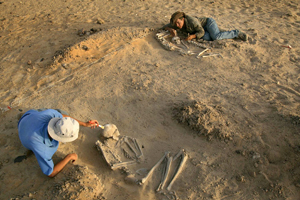Paleontologist Sereno earns award named for early dinosaur explorer
By Steve Koppesskoppes@uchicago.edu
News Office
 Photo by Mike Hettwer, courtesy of Project Exploration Professor Paul Sereno (in background), who also is a National Geographic Explorer-in-Residence, and archaeologist Elena Garcea excavate adjacent burials at Gobero, the largest graveyard discovered to date in the Sahara. Two seasons of excavation supported by the National Geographic Society revealed some 200 graves. |
|
Roy Chapman Andrews of the American Museum of Natural History led a 1922 expedition to Mongolia’s Gobi Desert to look for fossils of human ancestors. Instead he discovered several new species of dinosaurs and a fossilized nest of dinosaur eggs in what would become one of the most famous expeditions of the century.
Paul Sereno did Andrews one better. Sereno, Professor in Organismal Biology & Anatomy, led an expedition to Africa’s Sahara Desert in 2000 to look for dinosaurs. But in addition to many new species of dinosaur and extinct crocodilians, Sereno’s expedition also turned up a vast graveyard of human fossils.
Now Sereno is slated to receive the seventh annual Roy Chapman Andrews Society Distinguished Explorer Award on Thursday, Jan. 22 at Beloit College in Wisconsin.
Andrews (1884-1960) was a native of Beloit. Previous recipients of the award include Robert Ballard, discoverer of the RMS Titanic; and Steve Squyres, lead scientist of the Mars Exploration Rover mission.
Said Sereno: “I see paleontology as ‘adventure with a purpose.’ How else to describe a science that allows you to romp in remote corners of the globe, resurrecting gargantuan creatures that have never been seen?”
Sereno has hunted fossils on five continents. His latest discovery, announced last August at a news conference at National Geographic headquarters in Washington, D.C., made international headlines. During the news conference and in a paper published in the electronic Public Library of Science ONE, Sereno and his associates described Gobero, the largest Stone Age graveyard in the Sahara.
Their discovery provides an unparalleled record of life when the region was green as recently as 4,000 years ago. At Gobero, two successive cultures thrived lakeside in a Green Sahara.
![[Chronicle]](/images/sidebar_header_oct06.gif)